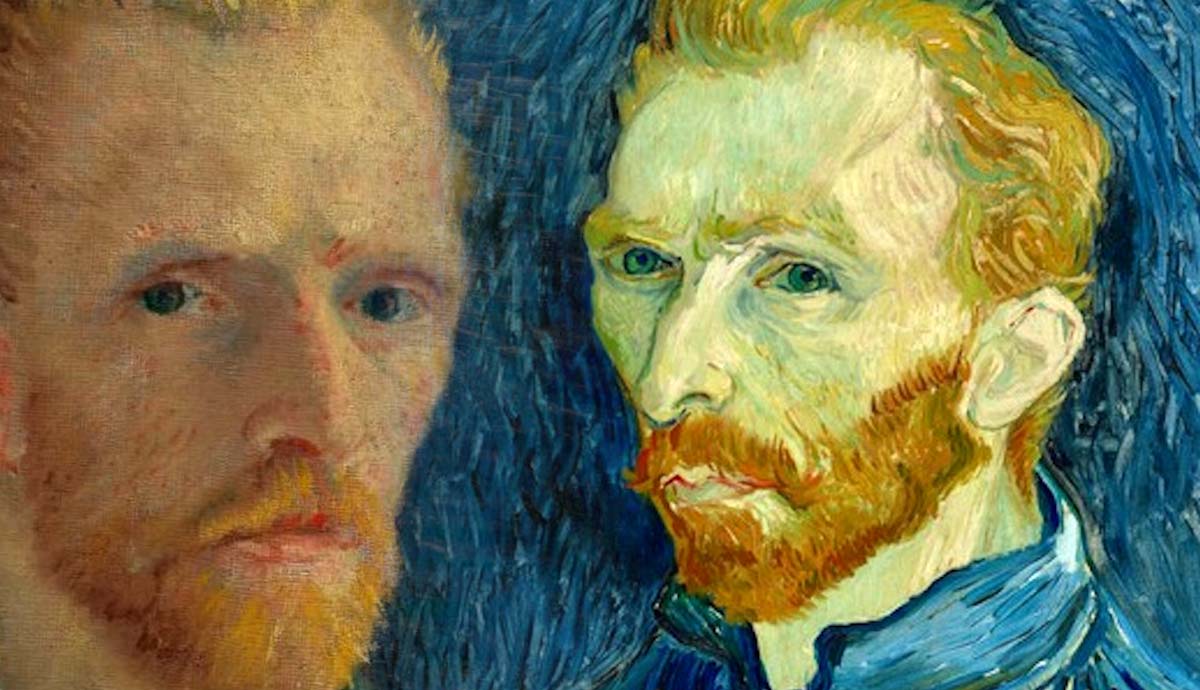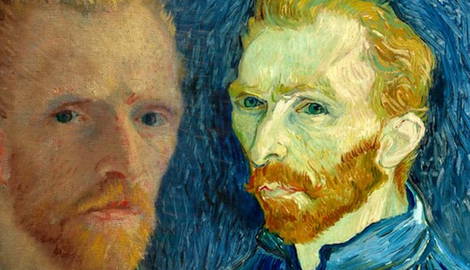
While developing his artistic skill, Dutch post-impressionist painter Vincent van Gogh struggled to find models and turned to the art of self-portrait as a form of practice. He first painted himself in 1885 and followed that portrait with many more after he moved to Paris in 1886. He continued to create these paintings in Arles and Saint-Remy. Van Gogh ended up painting over thirty-five self-portraits, all featuring his red hair and green eyes but with differences in the way he chose to depict his face. When looked at side-by-side, these paintings show a progression of the artist’s skill, personality, and self-image.
Self-Portrait with Pipe – Paris, September/November 1886

Self-Portrait with Pipe is one of the first known self-portraits by Vincent van Gogh. The work was created sometime between September and November of 1886 when Van Gogh was living in Paris and associating with members of the avant-garde movement, including Paul Gauguin and Émile Bernard. This painting was inspired by another artist, Adolphe Monticelli, a French romantic painter whose work sparked creativity in Vincent. He practiced the style of Monticelli’s work when creating this portrait, mimicking the dark tones and lighting used in the period before the Impressionists. Van Gogh’s face stands in contrast to the burgundy background of the oil painting.
Self-Portrait – Paris, July/August 1887

This is another of the self-portraits Van Gogh painted while living in Paris. While many of the portraits he painted during this summer show him wearing an artist’s smock, he wears a more formal suit jacket in this one. His expression in this portrait is piercing, and his eyes match the colors of his clothing and the background. To save money, Van Gogh often painted on both sides of a canvas. This piece is one of his dual-sided works and is displayed at the Van Gogh Museum in Amsterdam in a clear case so visitors can see the paintings on both sides.
Self-Portrait with Straw Hat – Paris, Summer 1887

Another portrait from the summer of 1887, Self-Portrait with Straw Hat shows a more lighthearted side to Vincent van Gogh. He wears his artist’s smock and a straw hat in this portrait, and the colors used are light and airy. Van Gogh used these portraits as a form of practice, which may be why he painted so many in the summer of 1887. In a letter to his brother Theo in 1888, he explained his reasoning for painting self-portraits: “If I can manage to paint the coloration of my own head, which is not without presenting some difficulty, I’ll surely be able to paint the heads of the other fellows and women as well.”
Self-Portrait with Pipe and Straw Hat – Arles, Summer 1888

Yet another self-portrait of Vincent wearing a hat, this piece takes on a highly impressionist quality due to the brush strokes and choice of color. The artist wears his painter’s smock and has a pipe between his lips. Compared to the other self-portrait with a straw hat, Van Gogh’s hair and beard are slightly darker. Because only one known photograph of Vincent van Gogh is known to exist, these portraits give the best idea of what he might have looked like.
Self-Portrait with Grey Felt Hat – Paris, September/October 1887

Self-Portrait with Grey Felt Hat was painted in the autumn of 1887 and it remains a bold example of Van Gogh’s artistic experimentation at the time. The work is made up of tiny, multicolored brush strokes that are reminiscent of the pointillist technique. He used a wide variety of blue, orange, red, green, and purple to create the image. Though the purple shades have since faded to blue, the contrast of colors in this self-portrait is still stunning.
Self-Portrait as a Painter – Paris, December 1887/February 1888

This is one of the last self-portraits Van Gogh created while living in Paris, in late 1887 or early 1888. In this work, the artist depicted himself performing his chosen profession, complete with an artist’s smock, palette, paintbrushes, and canvas. While Van Gogh is considered one of the most prominent post-impressionist painters today, he was not widely known as an artist during his lifetime. This work is a rare reflection of Van Gogh’s posthumous legacy as a great artist.
Painter on His Way to Work – Arles, July 1888

Painter on His Way to Work (1888) is a unique self-portrayal because Van Gogh illustrated himself as a figure against a landscape, as opposed to a traditional portrait. Also known by the title The Painter on the Road to Tarascon, this piece gives insight into Vincent’s daily life in Arles. He referenced this painting in a letter to his brother Theo, saying: For example, there’s a quick sketch I made of myself laden with boxes, sticks, a canvas, on the sunny Tarascon road. Sadly, this work was presumed to be destroyed in an air raid on Germany during World War II. The painting, along with others from the collection of the Kaiser-Friedrich Museum, was inside a salt mine that caught fire in the raid and has not been seen since.
Self-Portrait Dedicated to Paul Gauguin – Arles, September 1888

Van Gogh was such a proponent of using self-portraits as a practice that he encouraged his friends and fellow artists to paint them as well. Self-Portrait dedicated to Paul Gauguin (1888) was sent as part of an exchange of self-portraits between Van Gogh, Paul Gauguin, and Émile Bernard. Shortly after this, Gauguin would come to stay with Vincent in Arles for a period of 63 days, which resulted in the dissolution of their friendship. After their fight, Gauguin sold this portrait to Parisian art dealer Ambrose Vollard for 300 francs.
Self-Portrait with Bandaged Ear – Arles, January 1889

Self-Portrait with Bandaged Ear (1889) is a portrait painted in the aftermath of Paul Gauguin’s departure from the house they shared in Arles. At the end of December 1888, Van Gogh suffered an episode in which he cut off a large portion of his left ear. Gauguin left their shared accommodation after that night, and the two men never saw each other again, though they continued to communicate by letter. The artist depicted himself here with a bandaged ear, a fur cap, an easel, and a Japanese print hanging on the wall.
Self-Portrait – Saint-Rémy, August 1889

This self-portrait was painted in August of 1889 when Van Gogh was hospitalized at the Saint-Paul Asylum in Saint-Rémy, France. His time in the asylum was artistically prolific, and he painted many self-portraits showing himself from the side with his remaining ear. He holds a palette and wears an artist’s smock in this bold portrait, providing insight into Van Gogh’s continuing self-image as an artist.
Self-Portrait – Saint-Rémy, September 1889

This self-portrait is one of two candidates for the final self-portrait Vincent van Gogh created before his death in July of 1890. Though Vincent lived in the Paris suburb of Auvers-sur-Oise for a time after leaving Saint-Rémy, it is not thought that he painted any more self-portraits during that time. Van Gogh’s use of swirling turquoise shades in this painting provides a striking contrast to the color of his hair and beard. Rather than his artist’s smock, he wears a blue suit in this portrait.
Van Gogh’s Self-Portrait Without Beard – Saint-Rémy, September 1889

Also painted in September of 1889, this is another work that was possibly Van Gogh’s last self-portrait. Although Van Gogh’s iconic red beard is not present in this work, the artist’s smock and green background call back to many of his other self-portraits. He gave this painting as a birthday gift to his mother, and today it is known as one of the most expensive paintings ever sold at a private auction.










